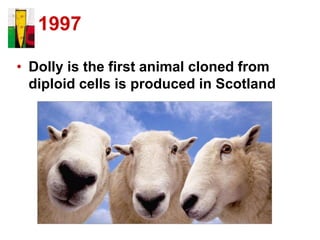LECTURE 1 introduction_to_biotechnology.ppt
- 2. What is Biotechnology? • Biotechnology is the manipulation of living organisms and organic material to serve human needs. • Examples: – Yeast in bread making and alcohol production – Use of beneficial bacteria (penicillin) to kill harmful organisms – Cloning of plants and animals – Artificial insemination
- 3. Biotechnology Industry • Research is conducted by small companies, large corporations, and public universities.
- 4. Biotechnology Industry • Funding comes from a variety of sources: – Public (government) – Private (companies and foundations) • California passed a $300 billion referendum for research in stem cells in 2004.
- 5. Biotechnology Industry • Focuses on a variety of research areas including: – Health/medicine – Food science – Environmental science – Agriscience
- 6. Impact of Biotechnology • Genetically modified organisms (GMOs) are consumed by millions of people (especially Americans) EVERY DAY. – Almost 56% of all soybean plantings worldwide are genetically engineered (much higher in the US)
- 7. Impact of Biotechnology • Genetically modified crops were produced on more than 167 million acres in 18 countries in 2003, a 15% increase from 2002 – The US was the largest single producer with more than 60% of the total acreage in production.
- 8. Impact of Biotechnology • The NC Biotechnology Center predicts that the biotechnology industry in the state will contribute more than $25 billion in annual income each year within the next 25 years.
- 10. Antony van Leeuwenhoek • 1675 • Discovers bacteria using a simple microscope
- 11. Gregor Mendel • 1863 • Austrian monk who conducted the first genetics experiments using pea plants in the mid 1800s. • Often considered the founder of genetics.
- 12. Louis Pasteur • 1870’s • Disproved the notion of spontaneous generation, describing the role of bacteria in spoilage and the scientific basis for fermentation • Created the rabies vaccine
- 13. Robert Hooke • 1665 • Invented the compound light microscope • First to observe cells in cork
- 14. James Watson & Francis Crick • 1953 • Englishmen responsible for the discovery of the double helix structure of DNA using X-ray photographs
- 15. Paul Berg • 1972 • Stanford University scientist who first developed recombinant DNA technology, a method for insertion of genetic material from one organism into another.
- 17. 1750 B.C. • Origins of “biotechnology” emerge in methods of food production and plant and animal breeding – Use of bacteria to produce cheese (food preservation) – Use of natural enzymes in yogurt – Use of yeast to produce bread – Use of fermentation for producing wine and beer
- 18. 1869 • DNA is discovered in trout sperm by German Miescher
- 19. 1919 • The word “biotechnology” is first used by a Hungarian agricultural engineer.
- 20. 1940’s-1950’s • Widespread work is undertaken to investigate the structure and function of DNA
- 21. 1980 • The U.S. Supreme Court approves the patenting of genetically altered organisms.
- 22. 1980’s-1990’s • A variety of GMO’s and biotechnology techniques are introduced in fields from agriculture to medicine – Recombinant DNA technology-extracts DNA from one organism for use in another, allowing more rapid and specific improvements in plants and animals – Plant Tissue Culture-gains widespread acceptance as a method to quickly and cheaply produce genetically identical plants
- 23. 1990’s • First transgenic organisms (GMO’s) are introduced in widespread agricultural production, particularly in the area of crops. – Bt corn and soybeans are introduced offering “natural” insect resistance by the introduction of a gene from the bacterium Baccillus thuringensis
- 24. 1997 • Dolly is the first animal cloned from diploid cells is produced in Scotland
- 25. Late 1990’s-Early 2000’s • Human cloning is outlawed in the U.S. and the first concerns over the use of human stem cells in research begin to arise.
- 27. Biotechnology and Agriscience • There has been increased activity and research between different agricultural areas with common research techniques and goals – Plant Science – Animal Science – Environmental Science – Health/Agri-Medicine
- 28. Plant Science • Wide scale production of transgenic plants impacting horticulture
- 29. Animal Science • Increased use of methods of in vitro fertilization and artificial insemination improve selected breed programs
- 30. Environmental Science • Use of biotechnology techniques in environmental science for cleaning contaminants and protecting endangered species – Bioremediation-use of natural organisms to clean contaminants
- 31. Environmental Science • Immunoassay tests are used to test for the presence of contaminants in soil, water and even blood • Installation of biological barriers to prevent the transfer of harmful microorganisms between production facilities – Example: Tire wash channels
- 32. Health/Agri-medicine • Pharming-the creation of plants and animals capable of producing medical substances • The use of biological barriers to prevent the spread of harmful microorganisms that could contaminate food sources
- 33. Health/Agri-medicine • DNA analysis/paternity testing has emerged as a technique to test the genetic ancestry of animals
- 35. Problems with Biotechnology • Transfer of genes found in transgenic organisms to natural populations. – Terminator genes have been used to minimize this risk
- 36. • Unexpected impacts of genetically modified organisms and biotechnology processes on other organisms and the environment Problems with Biotechnology
- 37. • Expense of the utilization of many biotechnology techniques – Cost of producing transgenic animals (There are transgenic fish, but no livestock yet.) Problems with Biotechnology
- 38. • Concerns over the safety and ethics of incorporating GMO’s into food for human consumption – Allergens – Example: The use of Starlink corn in taco shells not approved for human consumption Problems with Biotechnology
- 39. • Lack of education among both consumers and producers concerning biotechnology processes and products Problems with Biotechnology
- 41. Biotechnology Terms • Use your biotechnology books to define the following terms: – Cloning – Clonal Offspring – Deoxyribonucleic acid – Genetics – Genetic Engineering – GMO – Ribonucleic Acid – Transgenic Organism









































